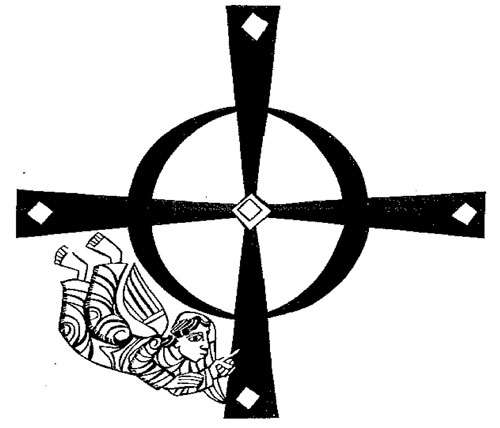The Symbols of the New Ambo
I hope that you have noticed the newly renovated AMBO. The wooden top of the ambo where the book of scripture is placed was made larger and more useable. The wooden top has been placed on a new square bronze sculptural box that is decorated with the Symbols of the Four Evangelists.
Traditionally, the four Gospel writers have been represented by the following symbols
- St. Matthew, a divine man
- St. Mark, a winged lion
- St. Luke, a winged ox; and
- St. John, a rising eagle.
These symbols are taken first from the Prophet Ezekiel (1:1-21) along with a similar description in the Book of Revelation (4:6-8). St. Irenaeus (140-202) likened these images to the four Gospels writers because of the content of their Gospels and their particular focus on Christ. They have appeared in Christian art since that time.
St. Matthew is represented by the divine man because the Gospel highlights Jesus’ entry into this world, first by presenting His family lineage – “A family record of Jesus Christ, Son of David, Son of Abraham (Mt. 1:1) – and His incarnation and birth: “Now this is how the birth of Jesus Christ came about: (Mt. 1:18). This then is the Gospel of Christ’s humanity.
St. Mark, represented by the winged lion, references the Prophet Isaiah when he begins his gospel: “Here begins the Gospel of Jesus Christ, the Son of God. In Isaiah the prophet it is written, ‘I send my messenger before you to prepare your way; a herald’s voice in the desert, crying, “Make ready the way of the Lord, clear Him a straight path.’” The voice in the desert crying “reminds one of a lion’s roar”. The lion also signifies royalty, an appropriate symbol for the Son of God.
The winged ox represents St. Luke. Oxen were used in temple sacrifices. St. Luke begins his Gospel with the announcement of the birth of St. John the Baptizer to his father, the priest Zechariah, who was offering sacrifice in the Temple. St. Luke also includes the parable of the Prodigal Son, in which the fatted calf is slaughtered, not only to celebrate the younger son’s return, but also to foreshadow the joy we must have in receiving reconciliation through our most merciful Savior who offered Himself in sacrifice to forgive our sins.
St. John is represented by the rising eagle. This Gospel begins with the “lofty” prologue and “rises” to pierce most deeply the mysteries of God, the relationship between the Father and the Son, and the incarnation. Jesus also identifies himself as “the way, the truth, and the life,” and anyone who accepts Him in that way will rise to everlasting life with Him.
While each of these symbols focuses on the particular theme of each Gospel, only in reading and reflecting on all four Gospels do we fully encounter our Lord.
Please take a moment to recognize and identify these traditional symbols of the Evangelists in our parish church.


